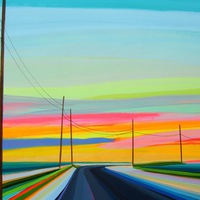Хочу совсем чуть-чуть поведать о самом молодом городе страны Иннополисе в Татарстане, в который нас занесло практически случайно в День России по дороге в Свияжск.
Среди большинства жителей Казани он считается закрытым, но мы совершенно беспрепятственно въехали в него и спокойно осмотрели снаружи все здания. Университет даже удалось поглядеть внутри из части холла. В общем, уровень его закрытости - вопрос дискуссионный.
Архитектурой городок весьма бодр. И в достроенном состоянии, когда из пейзажа исчезнут кучи перекопанного грунта и стройматериалов, будет похож, видимо, на кампусы Вены или Лиссабона без всяких скидок. И общественные пространства хороши. А над городом летают хищные птицы, добавляющие колорита.
Но есть и неясности. Зачем, строя в 2010-х годах в чистом поле город на 4 000 жителей, прорезать его насквозь четырёхполосной трассой и делать через неё только подземные переходы. Инновационность сразу куда-то начинает улетучиваться. Город-то проходится пешком насквозь за 15 минут. К чему все эти хайвеи?
Короче говоря, с дизайнерами и архитекторами в стране проблем у нас нет. Есть проблемы с заказчиками их работ. В случае с Иннополисом архитекторам дали самореализоваться. А вот с пониманием того, что такое комфортная для человека среда между этими зданиями, табличками, арт-объектами и живописнейшими трансформаторными будками есть существенные трудности. Похоже, никто не думал о сценариях, которые будут проживать иннополисяне (или как их правильно называть?) в этом новом лучшем мире. Нам ещё предстоит очень долгий путь для того, чтобы научиться думать про людей, а не про рендеры.
Ну и вторая, главная проблема: зачем вообще нужно было строить новый город в виде резервации вместо того, чтобы добавить жизни в один из уже существующих, но стагнирующих?
ЗЫ Простите, что не про тротуарную плитку и Ревзина с Навальным.
Фото Али Шариповой
Среди большинства жителей Казани он считается закрытым, но мы совершенно беспрепятственно въехали в него и спокойно осмотрели снаружи все здания. Университет даже удалось поглядеть внутри из части холла. В общем, уровень его закрытости - вопрос дискуссионный.
Архитектурой городок весьма бодр. И в достроенном состоянии, когда из пейзажа исчезнут кучи перекопанного грунта и стройматериалов, будет похож, видимо, на кампусы Вены или Лиссабона без всяких скидок. И общественные пространства хороши. А над городом летают хищные птицы, добавляющие колорита.
Но есть и неясности. Зачем, строя в 2010-х годах в чистом поле город на 4 000 жителей, прорезать его насквозь четырёхполосной трассой и делать через неё только подземные переходы. Инновационность сразу куда-то начинает улетучиваться. Город-то проходится пешком насквозь за 15 минут. К чему все эти хайвеи?
Короче говоря, с дизайнерами и архитекторами в стране проблем у нас нет. Есть проблемы с заказчиками их работ. В случае с Иннополисом архитекторам дали самореализоваться. А вот с пониманием того, что такое комфортная для человека среда между этими зданиями, табличками, арт-объектами и живописнейшими трансформаторными будками есть существенные трудности. Похоже, никто не думал о сценариях, которые будут проживать иннополисяне (или как их правильно называть?) в этом новом лучшем мире. Нам ещё предстоит очень долгий путь для того, чтобы научиться думать про людей, а не про рендеры.
Ну и вторая, главная проблема: зачем вообще нужно было строить новый город в виде резервации вместо того, чтобы добавить жизни в один из уже существующих, но стагнирующих?
ЗЫ Простите, что не про тротуарную плитку и Ревзина с Навальным.
Фото Али Шариповой
I want to tell you quite a bit about the youngest city of the country, Innopolis in Tatarstan, where we were brought almost by accident on the Day of Russia on the way to Sviyazhsk.
Among the majority of residents of Kazan, it is considered closed, but we entered it completely without hindrance and calmly inspected all the buildings from the outside. The university even got a glimpse inside from part of the hall. In general, the level of its closeness is a debatable issue.
The architecture of the town is very cheerful. And in the completed state, when heaps of excavated soil and building materials disappear from the landscape, it will probably look like the campuses of Vienna or Lisbon without any discounts. And the public spaces are nice. And birds of prey fly over the city, adding color.
But there are also ambiguities. Why, building a city for 4,000 inhabitants in an open field in the 2010s, cut it through with a four-lane highway and make only underground passages through it. Innovation begins to fade away somewhere. The city is walked through in 15 minutes. What are all these highways for?
In short, we have no problems with designers and architects in the country. There are problems with the customers of their work. In the case of Innopolis, the architects were allowed to fulfill themselves. But with an understanding of what a comfortable environment for a person is between these buildings, signs, art objects and the most picturesque transformer booths, there are significant difficulties. It seems that no one thought about the scenarios that the Innopolisians will live (or what should I call them correctly?) In this new, better world. We still have a very long way to go to learn to think about people and not about renders.
Well, the second, the main problem: why was it necessary to build a new city in the form of a reservation instead of adding life to one of the existing, but stagnating?
PS Forgive me that it's not about the paving slabs and Revzin and Navalny.
Photo by Ali Sharipova
Among the majority of residents of Kazan, it is considered closed, but we entered it completely without hindrance and calmly inspected all the buildings from the outside. The university even got a glimpse inside from part of the hall. In general, the level of its closeness is a debatable issue.
The architecture of the town is very cheerful. And in the completed state, when heaps of excavated soil and building materials disappear from the landscape, it will probably look like the campuses of Vienna or Lisbon without any discounts. And the public spaces are nice. And birds of prey fly over the city, adding color.
But there are also ambiguities. Why, building a city for 4,000 inhabitants in an open field in the 2010s, cut it through with a four-lane highway and make only underground passages through it. Innovation begins to fade away somewhere. The city is walked through in 15 minutes. What are all these highways for?
In short, we have no problems with designers and architects in the country. There are problems with the customers of their work. In the case of Innopolis, the architects were allowed to fulfill themselves. But with an understanding of what a comfortable environment for a person is between these buildings, signs, art objects and the most picturesque transformer booths, there are significant difficulties. It seems that no one thought about the scenarios that the Innopolisians will live (or what should I call them correctly?) In this new, better world. We still have a very long way to go to learn to think about people and not about renders.
Well, the second, the main problem: why was it necessary to build a new city in the form of a reservation instead of adding life to one of the existing, but stagnating?
PS Forgive me that it's not about the paving slabs and Revzin and Navalny.
Photo by Ali Sharipova




У записи 23 лайков,
1 репостов.
1 репостов.
Эту запись оставил(а) на своей стене Андрей Кочетков










































